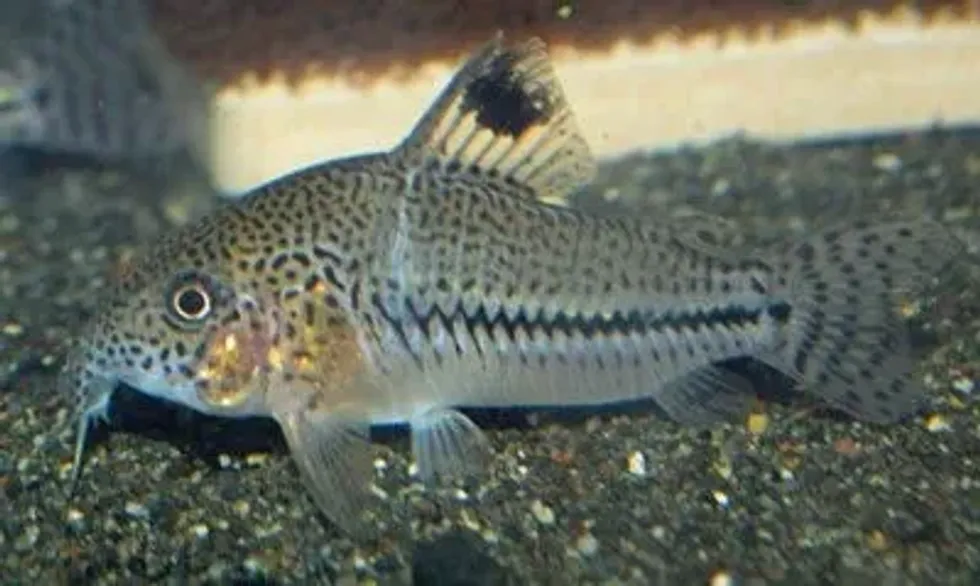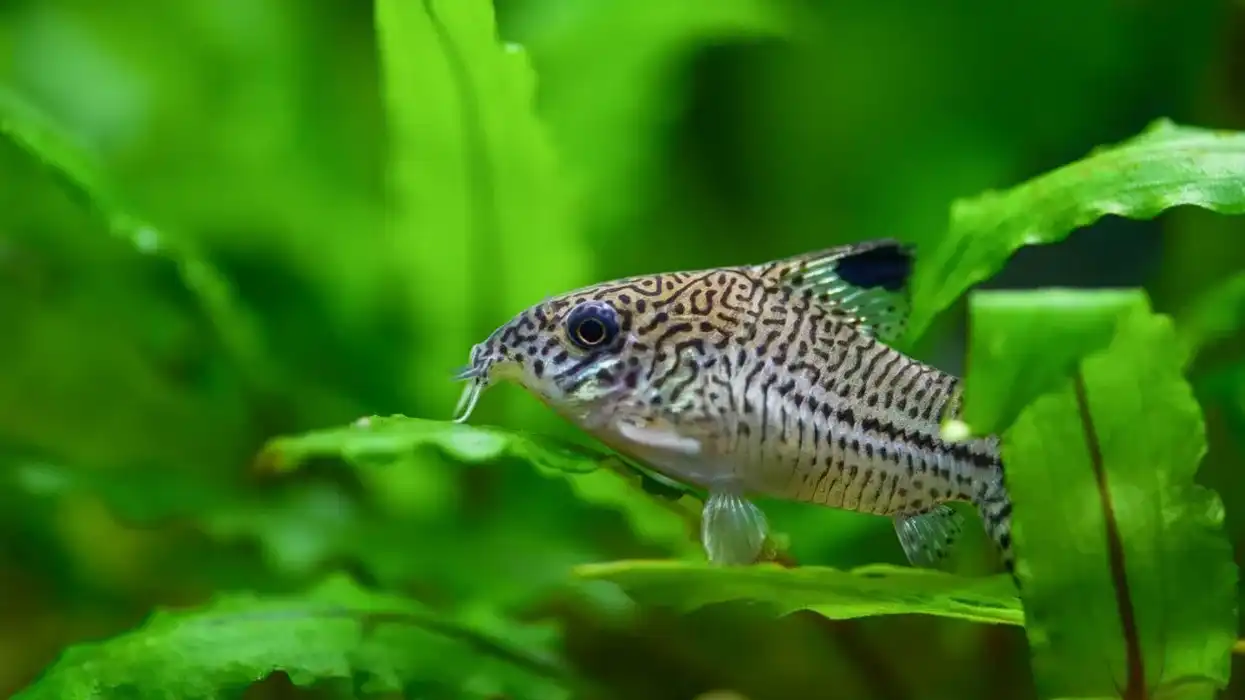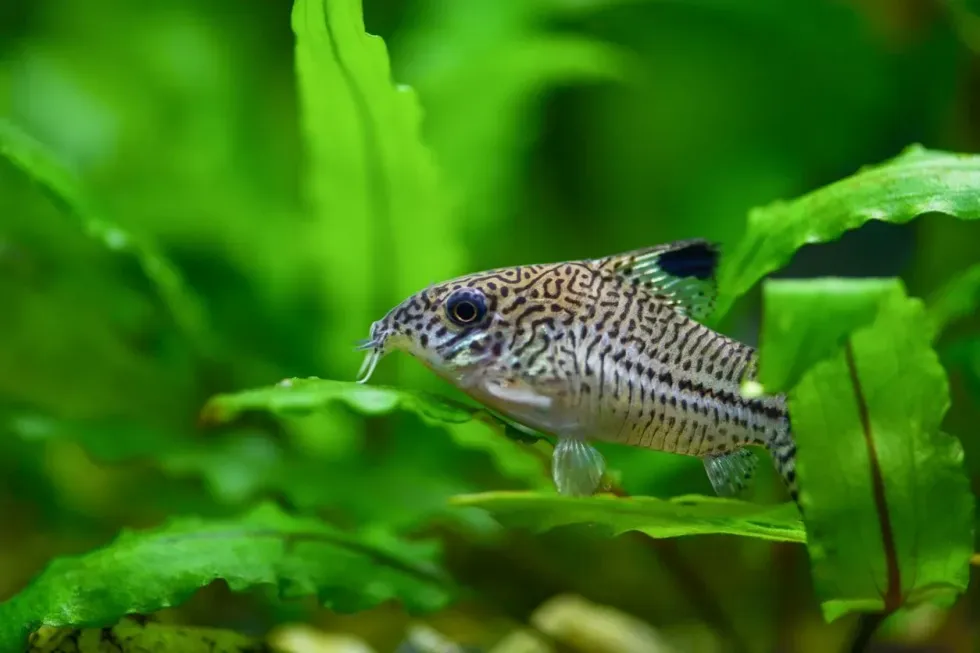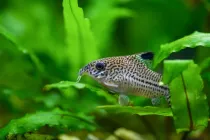Fun Cory Catfish Facts For Kids

Content
- What type of animal is a Cory Catfish?
- What class of animal does a Cory Catfish belong to?
- How many Cory Catfish are there in the world?
- Where does a Cory Catfish live?
- What is a Cory Catfish's habitat?
- Who do Cory Catfish live with?
- How long does a Cory Catfish live?
- How do they reproduce?
- What is their conservation status?
- What do Cory Catfish look like?
- How cute are they?
- How do they communicate?
- How big is a Cory Catfish?
- How fast can a Cory Catfish swim?
- How much does a Cory Catfish weigh?
- What are their male and female names of the species?
- What would you call a baby Cory Catfish?
- What do they eat?
- Are they dangerous?
- Would they make a good pet?
- Did you know...
- Keeping Cory Catfish
- Cory Catfish types
Cory catfish or Corydoras are freshwater fish that are very peaceful in nature. Cory catfish are found in great numbers in South American water and do not face any threat of extinction in the near future.
Cory catfish are comparatively available in a wider range of places in its family than other species of catfish. They display a diversified range of body shapes and colors.
These small fishes are characterized by the hard armor that covers their body and sharp venomous spines on them. The ideal tank size for a Corydoras to survive should typically range from 20-30 gallons. Corydoras are omnivorous in nature.
Most fishes are bottom-dwelling finding food in the sand and gravel. The Cory's peaceful nature lets them live with other species of catfish also in an aquarium.
Therefore, they are called community fish. If you are interested to know more facts about cory catfish and their species like peppered cory catfish facts, emerald green cory catfish facts, and the others then continue reading this article.
For similar content check out the articles on brook trout and remora facts too.
Cory Catfish Interesting Facts
What type of animal is a Cory Catfish?
The Cory catfish, also known as Corydoras catfish, is a popular freshwater fish of South America that is found commonly as a pet in an aquarium or tank. The Cory catfish has a large number of species under its genus having more or less similar features.
What class of animal does a Cory Catfish belong to?
All the species of Cory catfish belong to the class Actinopterygii.
How many Cory Catfish are there in the world?
Cory catfish are popular aquarium or tank fish and they are loved as a pet. The population of these aquarium fish is a bit hard to estimate.
They are transferred to an aquarium or tank from the water on a large scale and perform reproductive activities by themselves in those tanks or aquariums. Since no such special efforts are required to propagate reproduction in these fishes, it is assumed that their population has not decreased much.
Where does a Cory Catfish live?
Corydoras shows endemism or the practice of sticking to their native land but their restricted areas include more places than other callichthyids catfish. The Cory catfish is native to South America.
They are found almost anywhere where its family has left traces except Panama. Their extent ranges from the eastern foot of the Andes Mountain to the coast of the Atlantic Ocean and from Trinidad to northern Argentina's Río de la Plata drainage.
In the wild, they prefer to stay mostly in shallow and calm water. Apart from their natural habitat, Corydoras can also exist in an aquarium or tank if the water is made suitable for them.
What is a Cory Catfish's habitat?
A Cory catfish is a fish of tropical water. They inhabit mainly the slow-moving rivers. These fishes are usually found in nearly stagnant and small streams lining the large rivers, ponds, or marshes.
It lives in shallow water with soft substrates like sand and gravel that are a bit murky. They are also found in aquariums or tanks if they get suitable living conditions there.
The areas in which they live have river banks covered with dense vegetative growth. In the wild, these catfish may reside on sharp substrate. The poor water quality results in eroding the barbels of these fish.
Who do Cory Catfish live with?
The Cory catfish can either survive alone or in a group also called a shoal. In the wild a large number of fish aggregate together to form big groups.
In an aquarium or tank, Corydoras prefer to live in a group of a minimum of six fishes. Living in a group gives them a feeling of safety.
However, a single species of catfish Corydoras prefer to live with the fish of the same species rather than fishes of different species. The larger the number of fish in a tank, the more gallons of water is required for these fishes to survive.
How long does a Cory Catfish live?
The lifespan of Corydoras when they live in the wild differs widely from the lifespan when they live in an aquarium or tank. In general, Corys are believed to live for a span of five to seven years.
When they are held captive and raised in an optimum environment, ideal for their growth, Corydoras can stay alive for more than 20 years. One species of Corydoras holds the highest record of staying alive till 27 years.
How do they reproduce?
Corydoras catfish are social fish and they breed both in the wild as well as when are held in captivity. All species portray more or less similar types of reproduction patterns.
Some species of this fish like the bronze cory, and the albino cory follow a unique insemination method. In these species of fish, the male and the female fish reproduce in a T-position.
In this position, the male releases the reproductive gamete into the female fish's mouth from its abdomen. The gamete then passes through the intestine of the female fish and gets discharged in a pouch along with the eggs.
The females keep this pouch far away in isolated places. Some species of the Corys also indulge in cross-breeding among themselves.
When they are kept as pet fish in an aquarium or tank these bottom-dwelling fishes breed randomly without needing any effort. Since their mating season starts in the rainy season, making the aquarium water cooler helps to imitate their mating season.
For their mating process, it is better to use a different tank without any substrate since the parent fishes might feed on their own eggs reducing the number of eggs. If proper conditions are met, Corydoras can lay eggs weekly.
What is their conservation status?
The conservation status of Cory cats is not evaluated under the IUCN Red List. Since their population is still not known clearly, it is not possible for IUCN to put them under any category.
However, it is believed that there are a number of species of Cory catfish and they are present in different parts of South America in aquariums.
Cory Catfish Fun Facts
What do Cory Catfish look like?
Corydoras catfish are small fish of peaceful nature found in the tropical areas of South America. In general, Corys have a wedge-shaped body with a small face.
The adorable white eyes have a ring around them making them look wider. On the nose three pairs of whiskers like barbels are present.
The barbels help the Corys to locate their food in the substrate. Their bodies are protected by bony armor that runs throughout the length of the body.
The underside of this bottom feeder is flat and well adapted to stay in the lowest levels of water. Their pectoral fins are horizontal and help the fish to rest in the bottom of the tank or aquarium. The sail-like dorsal fins of the fish are either pointed in some species or round in the others.
The tail fin is forked and is of different sizes in different species. Some species also possess venomous spines that give protection from predators in the water.
Corydoras catfish have the ability to take camouflage since their body colors help to blend completely with the substrate. The different colors in which these peaceful fishes are available are shades of pale or albino, shimmering colors like emerald, and brown.

How cute are they?
Corydoras do not only have awesome personalities but they also look very adorable. They are liked very much for their beautiful appearance and kept in aquariums or a tank. Corydoras portray some of the vibrant colors. Its big round eyes make them look really cute too.
How do they communicate?
The most common communication methods of fishes include communication through color, smell, electrical impulses, and motion. Likewise, cory cats also communicate with their tank mates utilizing these similar methods.
How big is a Cory Catfish?
Corydoras are small peaceful fish found in groups either in an aquarium or in freshwater regions. The average length of their body measures 2.5 in (6.4 cm).
The length of the smallest fish of the species might just be over an inch while the largest species remain under 5 in (12.7 cm). The pygmy cory is the smallest species of this fish.
How fast can a Cory Catfish swim?
Although peaceful in nature, Corydoras catfish are fast-moving small fishes that tend to jump out of the water when they are contained in an aquarium or tank. For this reason, it is important to put a lid on the aquarium or tank containing these species of fish.
The swim bladders of these slim-toned fish do not face any problem as such. However, the speed of Corys is not determined by scientists yet.
How much does a Cory Catfish weigh?
Corydoras are lightweight fishes because of their small size. The weight of the most common species of Corydoras, the peppered cory, is around 0.4 oz (11.2 g).
What are their male and female names of the species?
Male and female Corydoras do not have any specific names for their species. Both of them are just called Corydoras.
What would you call a baby Cory Catfish?
The babies of all species of fish are called fry. Since a Cory catfish is also a type of fish, their baby is known as fry.
What do they eat?
Corydoras are called bottom dwellers that forage for food in the bottom of the water body. Corydoras are bottom feeder fish that generally scavenges the bottom of their tanks cleaning it completely. They dig into the substrate present at the bottom and suck small insects, worms, and larvae.
Their food also includes any vegetative matter that they find in the water. When held in captivity, sinking pellets in their diet best imitate their scavenger diet of the wild.
These fishes like to eat shrimp pellets, algae wafers, and bottom feeder tablets very much. Their most favorite treat includes bloodworms and daphnia. Corys also feed on the eggs of other fishes sometimes.
Are they dangerous?
Corys are friendly fish and very famous as pets. They are absolutely not harmful.
However, the spines present in the body of some species of cory catfish are poisonous. When they feel afraid, they emit toxins from these spines which can mildly irritate the bare skin of people. They can also cause harm to themselves by their destructive defense mechanism of self-poisoning which might even cause death.
Would they make a good pet?
The peaceful nature of all these species has made them great pets. They are also called community fishes and their social nature makes them very friendly to other species as well. They are very active fish and entertaining in an aquarium.
Did you know...
Corys have the capability to intake oxygen for some time if the water quality worsens.
Keeping Cory Catfish
Two of the most important measures that are to be taken to keep a Corydoras are to maintain the tank size and water conditions. The water should have a pH level of 7 -8 and the temperature should vary between 74-80 degrees.
A tank size of 20-30 gallons is enough for a beginner aquarist to start petting Cory cats in it. A separate tank for Cory catfish eggs is also required.
There should be continuous water changes in these tanks. A proper dose of food should be provided to them when in a tank.
Cory Catfish types
Cory catfish or Corydoras have over a hundred species under them. Some of the famous species that are widely known are namely, panda cory catfish, peppered cory catfish, albino cory catfish, pygmy cory catfish, green cory catfish, Julii Cory catfish, and sterbai cory catfish.
The panda cory has black patches around its eyes that resemble the eye patches of a panda. The panda cory also requires good water quality as they are mainly found in rivers containing meltwater from glaciers.
The pygmy cory is the smallest of all species and cannot be kept with larger fishes in the same tank. The Julii Cory is a bit difficult to find.
A Julii Cory is covered with black spots on the body. They can move their eyes in such a way which looks like the Julii Cory catfish is winking.
The sterbai cory is among one of the popular species characterized by white spots on its dark body. The emerald cory cats are the most beautiful species flaunting their iridescent scales.
The peppered cory cats are the most common species that are found as pets. Albino corys are a special type of peppered corys whose eyes have a glowing tinge and are exclusively available from breeders.
Here at Kidadl, we have carefully created lots of interesting family-friendly animal facts for everyone to discover! Learn more about some other fish including wels catfish, or fluke fish.
You can even occupy yourself at home by drawing one on our Cory Catfish coloring pages.
We Want Your Photos!
More for You
Sources
https://en.wikipedia.org/wiki/Corydoras
https://www.iucnredlist.org/search/stats?taxonomies=167526&searchType=species
https://www.thesprucepets.com/cory-species-1381075
See All
Bachelor of Arts specializing in Journalism and Mass Communication, Postgraduate Diploma in Sports Management

Moumita DuttaBachelor of Arts specializing in Journalism and Mass Communication, Postgraduate Diploma in Sports Management
A content writer and editor with a passion for sports, Moumita has honed her skills in producing compelling match reports and stories about sporting heroes. She holds a degree in Journalism and Mass Communication from the Indian Institute of Social Welfare and Business Management, Calcutta University, alongside a postgraduate diploma in Sports Management.
Bachelor of Technology specializing in Computer Science Engineering

Shray SharmaBachelor of Technology specializing in Computer Science Engineering
As an aspiring web and app developer, Shray has a passion for working with promising startups. He is currently pursuing a Bachelor's degree in Computer Science from Maharaja Surajmal Institute Of Technology while gaining experience in digital marketing. Shray has already earned a Google Analytics Certification and is well-equipped to handle analytics and data management tasks. He has also served as a marketing manager at Parallax Virtual Arts, where he oversaw the company's social media, content, and SEO strategies. Shray's goal is to create engaging content that resonates with audiences and offers valuable insights.
Disclaimer
1) Kidadl is independent and to make our service free to you the reader we are supported by advertising. We hope you love our recommendations for products and services! What we suggest is selected independently by the Kidadl team. If you purchase using the Buy Now button we may earn a small commission. This does not influence our choices. Prices are correct and items are available at the time the article was published but we cannot guarantee that on the time of reading. Please note that Kidadl is a participant in the Amazon Services LLC Associates Program, an affiliate advertising program designed to provide a means for sites to earn advertising fees by advertising and linking to Amazon. We also link to other websites, but are not responsible for their content.
2) At Kidadl, we strive to recommend the very best activities and events. We will always aim to give you accurate information at the date of publication - however, information does change, so it’s important you do your own research, double-check and make the decision that is right for your family. We recognise that not all activities and ideas are appropriate for all children and families or in all circumstances. Our recommended activities are based on age but these are a guide. We recommend that these ideas are used as inspiration, that ideas are undertaken with appropriate adult supervision, and that each adult uses their own discretion and knowledge of their children to consider the safety and suitability. Kidadl cannot accept liability for the execution of these ideas, and parental supervision is advised at all times, as safety is paramount. Anyone using the information provided by Kidadl does so at their own risk and we can not accept liability if things go wrong.
3) Because we are an educational resource, we have quotes and facts about a range of historical and modern figures. We do not endorse the actions of or rhetoric of all the people included in these collections, but we think they are important for growing minds to learn about under the guidance of parents or guardians.







